Shortly after we left Banff National Park, we saw our first oil derrick pumping away. It looked quite pretty with its multi-coloured paint, so we stopped and took a photo. Little did I know just how much oil and gas infrastructure we would pass by in the following days.
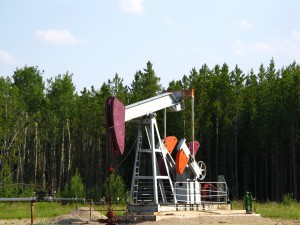
It was the ride from Rocky Mountain House to Lacombe which first gave me a flavor for the scope of the industry. It seemed every few minutes we would pass by another oil derrick, pumping station or processing plant. Then I started noticing the pipelines. Little signs by the roadside indicated the type of pipeline and owner. We never seemed to be out of sight of one. After a few hours of this, I started to feel like it was all part of one giant machine, and we were ants crawling slowly across. There was farm and ranch land everywhere, surrounding and covering all this infrastructure, but it felt like a thin covering, partially concealing the giant machine.

Processing plant, flare stacks and nearby fields
Every so often, we would get a whiff of petrochemicals, either the complex scent of hydrocarbons or the rotten-egg smell of hydrogen sulphide from sour gas. Not exactly pleasant, and protests by locals and farmers against the sour gas wells have been ongoing for years. Lately there have been a number of bombings of sour gas processing equipment and pipelines, especially in British Columbia.

Warning signs for a Sour Gas facility
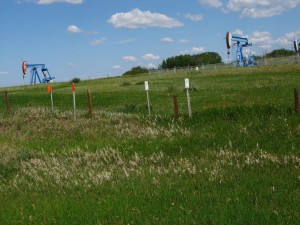
Derricks and signs for the pipelines under the road
In the ensuing days, we saw more and more, sometimes pipelines, sometimes oil transport trucks, but never out of sight of something for more than a few minutes. Occasionally we came across some new construction, either the scar of a recently constructed pipeline snaking across the fields, or active construction on a new plant or well. Even when we entered Saskatchewan the machine stretched on around us, with storage tanks, steam injection systems and more wellheads and pipelines.
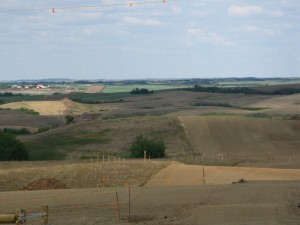
Recently constructed pipeline
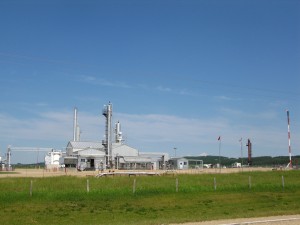
Another Sour Gas Facility. The windsock is so workers know which way to run if any of the alarms go off, since un-perfumed Natural Gas is odourless
In Western Saskatchewan, oil and gas exploration and construction is helping to keep the small towns alive, as fewer and fewer farmers are needed to work the land. As part of our farm tour, Clem showed us the nearby oil and gas infrastructure, including a new natural gas-powered generating station, which will be used to power the large Enbridge pumping station as well feed power into the grid for the surrounding area. He also pointed out that crops actually grow better on top of a pipeline, so you can see where the pipeline goes, even years after construction. We had noticed the distinct lines, but assumed they must be due to different crops or recent construction. People have hypothesized that the heat from the pipeline may help get the crops an early start, or the turning over of the earth leaves the soil in better condition.

Natural gas powered electrical generating station under construction
One thing we had not noticed was the underground natural gas storage facilities. These are massive salt cavern formations where gas is pumped underground until it is needed. I wonder how many other bits of this giant machine we missed?
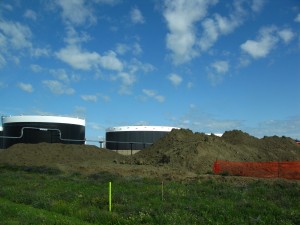
Huge oil storage tanks, much easier to notice than the underground salt caverns
It is a massive amount of infrastructure, all pumping non-renewable resources east and south to the voracious appetites of Eastern Canada and the United States. All this to give us the gasoline to fuel our cars and the natural gas to power our electrical plants and heat our homes. I hesitate to think what the area around the Tar Sands must look like! I found the engineering for this huge machine to be fascinating, but it is also scary to think of all the things which could go wrong.
Even if nothing goes wrong, we’re behaving as if there is a limitless supply of this stuff, and the quantities we’re using are huge. Throughout our travels, we saw how people in other countries – especially the less developed ones – conserve the energy they have (people actually unplug TVs and appliances when they are not in use – they drive small cars and use public transport). Now that we’ve returned to Canada, we see so much waste it is no wonder our energy use and carbon footprint are so high. It is easy to wonder at the lack of sustainability in a typical Canadian lifestyle, and we wonder how our lifestyle will change when we get back home and become “normal” again.